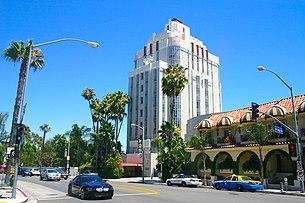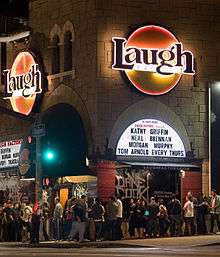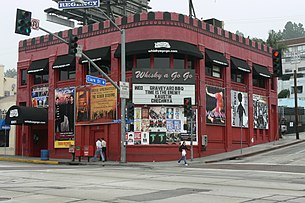Sunset Strip
The Sunset Strip is the 1.5-mile (2.4 km) stretch of Sunset Boulevard that passes through the city of West Hollywood, California. It extends from West Hollywood's eastern border with the city of Los Angeles at Marmont Lane to its western border with Beverly Hills at Phyllis Street. The Sunset Strip is known for its boutiques, restaurants, rock clubs, and nightclubs, as well as its array of huge, colorful billboards.

History
Prior to the 1984 incorporation of the city of West Hollywood, the Sunset Strip lay in an unincorporated area of Los Angeles County. Because of this, the Sunset Strip and all of West Hollywood gained a reputation for being a loosely regulated area, in large part because it was not under the jurisdiction of the Los Angeles Police Department.
1920s
Gambling was illegal in the city of Los Angeles, but legal in unincorporated Los Angeles County, which fostered the development of rather wilder nightlife in West Hollywood than was found within the city limits. In the 1920s a number of nightclubs and casinos moved in along Sunset Strip, which attracted movie people; alcohol was served in back rooms during Prohibition.
1930s and 1940s
In the 1930s and the 1940s, restaurants and nightclubs on Sunset Strip, like Sherry's, Ciro's, the Mocambo and the Trocadero, were patronized by people working in the movie industry. Some of its expensive nightclubs and restaurants were said to be owned by gangsters like Mickey Cohen and Bugsy Siegel, earning Sunset Strip a place in Raymond Chandler's 1949 Philip Marlowe novel, The Little Sister. Also on Sunset Strip are the Garden of Allah apartments—Hollywood quarters for transplanted writers like Robert Benchley, Dorothy Parker, and F. Scott Fitzgerald—and Schwab's Drug Store.
1960s
By the early 1960s, Sunset Strip had lost favor with the majority of movie people, but its restaurants, bars and clubs continued to serve as an attraction for locals and tourists. In the mid-1960s it became a major gathering place for the counterculture and was the scene of the Sunset Strip curfew riots in November 1966, involving police and crowds of young club-goers. Those riots inspired the Buffalo Springfield song "For What It's Worth".
Sunset Strip became popular with rock musicians and their fans. Bands such as Led Zeppelin, The Doors,[1] The Byrds, Love, The Seeds, Frank Zappa, and others played at clubs like Gazzari's, the Whisky a Go Go, the Roxy, Pandora's Box and the London Fog. In July 1965 Go-Go dancers also began performing. The Hyatt West Hollywood (now known as the Andaz West Hollywood) became a popular hotel.
1970s
Rodney Bingenheimer's English Disco, influenced by Britain's glam rock movement, opened in 1972. It became a hangout for musicians, including The Stooges and the New York Dolls.[2] The 1979 Donna Summer song "Sunset People", from the album Bad Girls, was about the nightlife on Sunset Boulevard. Sunset Strip continued to be a major focus for punk rock and new wave music during the late 1970s
1980s
This decade became the home of numerous glam metal bands such as Quiet Riot, Mötley Crüe, Ratt and LA Guns, the Sunset Strip ceased to be a major area for up and coming rock bands without industry sponsorship. The adoption of "pay to play" policies, where bands were charged a fee to play at clubs, diminished its appeal to groups, other than as an industry showcase. As of the 2010s, the music industry establishment continues to dominate the clubs on Sunset Strip.
In November 1984, voters in West Hollywood passed a proposal on the ballot to incorporate and the area became an independent city. Increasingly, the western end of Sunset Strip was occupied by office buildings, mostly catering to the entertainment industry, and hotels.
1990s
During the 1990s, the center of the alternative music activity in Los Angeles shifted further east to areas like Echo Park, Los Feliz and Silver Lake.
Landmarks
| Fairfax Avenue | Fairfax Avenue |
| The Viper Room | Whisky a Go Go |
| Tiffany Theater | |
| Rainbow Bar and Grill | |
| Crescent Heights Boulevard | Crescent Heights Boulevard |
| 9200 Sunset | |
| Hacienda Arms Apartments | |
| La Cienega Boulevard | La Cienega Boulevard |
| London Fog | |
| Troubadour | |
| San Vicente Boulevard | San Vicente Boulevard |
| Roxy Theatre | |
| Doheny Drive | Doheny Drive |
| Gazzarri's | |
| Troubadour | |
| Sierra Drive | Sierra Drive |
In popular culture
77 Sunset Strip, a 1958–1964 TV series, was set on Sunset Strip between La Cienega Boulevard and Alta Loma Road, although the address was fictional, as street numbers there run in the 7000-8000s. A second crime drama, Dan Raven, starring Skip Homeier, aired on NBC during calendar year 1960, also set on Sunset Strip. Dan Raven featured several celebrities appearing as themselves, including Bobby Darin, Marty Ingels, and Paul Anka. The 1979 film Hardcore had scenes from Sunset Strip when George C. Scott's character Jake Van Dorn flew to Los Angeles to find his missing teenage daughter.
Studio 60 on the Sunset Strip was a behind-the-scenes television drama of a late-night comedy sketch show performed at a fictional theater on Sunset Strip.
Premiering on January 27, 2006, in Los Angeles at Vanguard Hollywood,[lower-alpha 1] the Rock of Ages stage production inspired the 2012 film of the same name. Its story line is centered along Sunset Strip in 1987.[3][4][5][6][7][8][9][10]
The 2010 film Burlesque is set at a fictional neo-Burlesque club on Sunset Strip.
The video game Grand Theft Auto V features a parody of the Whisky-a-go-go, named Tequi-la-la, a bar established in Eclipse Blvd, in the fictional city of Los Santos, based on Los Angeles.
Los Angeles-based artist Edward Ruscha created the artist's book Every Building on the Sunset Strip in 1966.[11][12]
Notes
- Beginning on July 27, 2005, a 45 minute showcase of Rock Ages was first produced at the King King along Hollywood Boulevard in Los Angeles.[3][4][5]
References
- Dickey 2003, p. 389.
- Chick 2009, p. 51.
- McDonnell, Evelyn (February 15, 2011). "'Rock of Ages' set for a victory dance at Hollywood's Pantages: The hair-metal musical left L.A. to strike it big on Broadway. Now it returns to Hollywood Boulevard a bona-fide hit and a Pantages headliner". Los Angeles Times. Retrieved October 25, 2016.
- "'Rock of Ages' returns to the Pantages in Hollywood starring Dominique Scott in vintage 1980's redux". Los Angeles Life and Style. February 8, 2012. Retrieved October 25, 2016.
- Lee, Ashley (November 18, 2014). "'Rock of Ages' to Take Final Broadway Bow: The musical will close on Jan. 18 after a six-year run". The Hollywood Reporter. Retrieved October 25, 2016.
- BWW News Desk (November 30, 2005). "Laura Bell Bundy Stars in 'Rock of Ages' Tuner in LA Jan 26 – Feb 18". www.broadwayworld.com. Retrieved October 25, 2016.
- BWW News Desk (December 18, 2008). "Rock of Ages Storms To Broadway 4/7, Previews Begin 3/20". www.broadwayworld.com. Retrieved October 25, 2016.
- BWW News Desk (December 6, 2010). "Musical Chairs - ROCK OF AGES to Move to Helen Hayes; RAIN to Brooks Atkinson". www.broadwayworld.com. Retrieved October 25, 2016.
- Weintraub, Steve "Frosty" (30 May 2012). "Director Adam Shankman Talks Turning Tom Cruise into Stacee Jaxx, Choosing Songs, and Much More on the Set of ROCK OF AGES". Collider. TopLingo. Retrieved 25 October 2016.
- Weintraub, Steve "Frosty" (30 May 2012). "20 Things To Know About ROCK OF AGES From Our Set Visit; Plus Video Blog Recap and Pics from Set". Collider.com. TopLingo. Retrieved 25 October 2016.
- Getty Research Institute
- The Metropolitan Museum of Art
- Bibliography
- Chick, Steve (2009). Spray Paint the Walls: The Story of Black Flag. Omnibus Press. p. 51. ISBN 978-0-857-12064-9.CS1 maint: ref=harv (link)
- Dickey, Jeff (2003). Rough Guide to Los Angeles. Rough Guides. ISBN 978-1-843-53058-9.CS1 maint: ref=harv (link)
External links
| Wikimedia Commons has media related to Sunset Strip. |
- The Sunset Strip – official site


